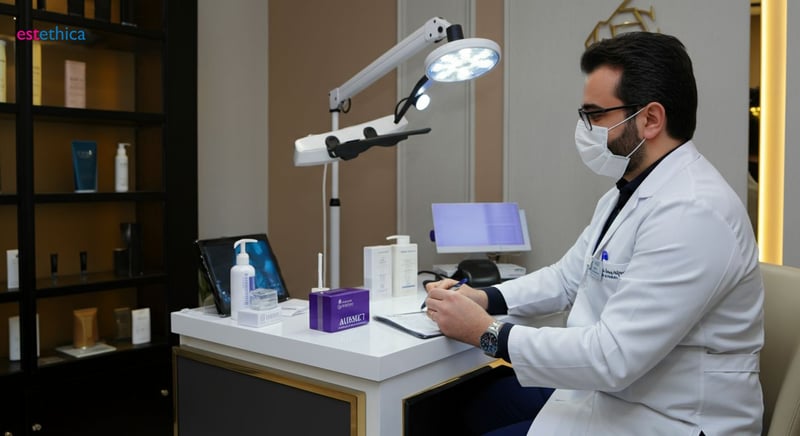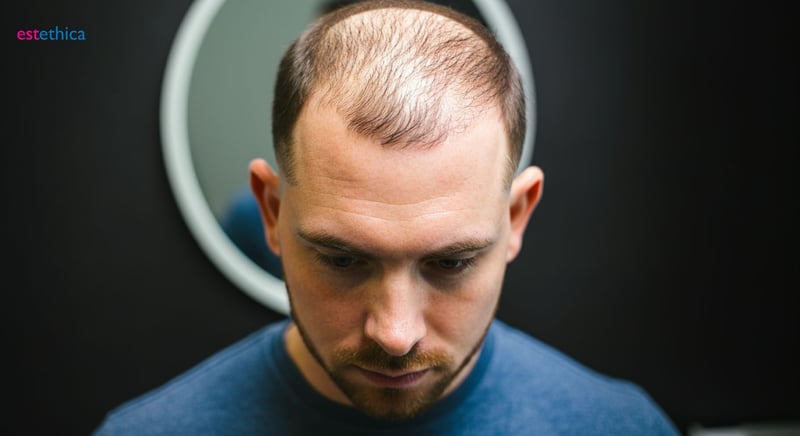Renew Your Look: Understanding Hair Transplant Options
Embark on a transformative journey with state-of-the-art hair restoration techniques like FUE and FUT. Achieve thriving, natural looking hair today.
Embarking on a journey to reclaim your hair is both exciting and filled with possibilities. With advanced solutions like Follicular Unit Extraction (FUE) and Follicular Unit Transplantation (FUT), the path to a fuller head of hair has never been more accessible. This comprehensive guide on hair transplantation unveils the science, permanence, and complementary treatments to ensure you make an informed decision that best fits your lifestyle and aesthetic goals.
The Science Behind Hair Restoration: How Transplants Work
Understanding Follicular Transfer and Hair Regrowth
Hair transplants leverage your natural follicular supply, primarily from the back of the scalp, to regrow hair on thinning areas. Here's how it works: surgeons remove small patches of hair, usually from the back or sides of the head, known as donor sites. After the removal, the harvested follicles are carefully implanted into the thinning areas of the scalp. The technique can be meticulously optimized using advanced technologies such as Sapphire FUE, which enhances precision and natural appearance. This method ensures grafts are placed with utmost accuracy, improving overall density and a natural-looking hairline.
Key Steps in Hair Transplant Procedures
- Extraction: Follicular units are extracted from donor areas typically located at the back of the head which are genetically resistant to balding.
- Preparation: The harvested follicles are carefully prepared and sorted under high magnification to ensure their viability.
- Implantation: The prepared follicles are then strategically implanted into the recipient areas of the scalp that have experienced thinning or balding to achieve the most natural-looking Hair Transplant Transformations.
The success of a hair transplant and long-term patient satisfaction depend on several factors, including the surgeon's skill, the quality of the donor hair, and how closely the surgeon follows established best practices. For example, surgeons consider the angle and direction of hair growth when implanting follicles to mimic natural hair patterns. estethica Global has a team of some of the most skilled surgeons for hair transplants.

FUE vs. FUT: Choosing the Right Hair Transplant Technique
Understanding FUE and FUT Procedures
When considering a hair transplant, understanding the fundamental differences between Follicular Unit Extraction (FUE) and Follicular Unit Transplantation (FUT) is crucial. FUE involves extracting individual hair follicles directly from the scalp, leaving tiny, almost invisible scars. This method is often preferred for its faster recovery time and minimal post-operative discomfort. On the other hand, FUT involves removing a strip of scalp from which the hair follicles are then extracted. Although FUT can harvest a larger number of grafts in one session, it results in a linear scar. estethica emphasizes personalized consultations to assess which method aligns best with each patient's hair loss pattern and aesthetic goals.
Benefits of FUE Over FUT
- Minimal Scarring: FUE leaves tiny, circular scars that are barely noticeable, even with short hairstyles.
- Faster Recovery: Patients undergoing FUE typically experience a quicker recovery compared to FUT, often returning to normal activities within days.
- Versatility: FUE is suitable for transplanting hair to various areas, including the scalp, eyebrows, and beard.
The choice between FUE and FUT depends on individual factors such as the extent of hair loss, hair type, and patient preferences. While FUT can be more efficient for extensive hair restoration, FUE offers distinct advantages in terms of scarring and recovery. estethica's approach, including techniques like Multi DHI, focuses on maximizing graft survival and achieving natural-looking results, irrespective of the chosen method.
The FUT Procedure and Its Benefits
- Strip Excision: A strip of hair-bearing scalp is removed from the donor area, typically the back of the head.
- Follicular Dissection: The strip is meticulously dissected into individual follicular units under microscopic guidance.
- Graft Placement: The prepared follicular units are transplanted into the recipient area following a customized plan.
FUT remains a viable option for patients requiring a large number of grafts due to its efficiency in harvesting. The linear scar can be managed effectively with proper suturing techniques and strategic hair styling. estethica ensures that patients are well-informed about the procedure and aftercare to minimize scarring and optimize the outcome. The expertise of the surgical team plays a crucial role in achieving a natural-looking hairline and satisfactory density, whether opting for FUE or FUT.

Is Hair Transplant Permanent? Exploring Long-Term Results
Factors Influencing the Longevity of Hair Transplants
While hair transplant procedures offer a lasting solution to hair loss, several factors play a crucial role in determining the permanence of the results. Proper aftercare is critical, as it supports the survival and health of the transplanted follicles. The characteristics of the donor's hair such as density and thickness, also impact the final outcome. Maintenance treatments, like PRP, can further enhance the longevity of transplanted hair by promoting scalp health and stimulating follicle growth.
Post-Transplant Care for Lasting Results
- Adherence to Aftercare Protocols: Following the clinic's specific post-operative instructions to ensure the transplanted follicles properly anchor and thrive.
- Lifestyle Adjustments: Adopting a hair-friendly lifestyle, including a balanced diet and avoiding harsh chemicals, to minimize stress on transplanted hair.
- Regular Scalp Maintenance: Implementing treatments recommended by hair care professionals at estethica to nourish the scalp and encourage healthy hair growth.
Hair transplant results often last for many years, with many patients experiencing continued growth from the transplanted follicles. A study published in the "Journal of Dermatological Treatment" found that over 85% of transplanted hair follicles are still actively growing after five years. estethica offers comprehensive support to ensure patients enjoy long-term satisfaction with their hair restoration results, including personalized consultations and follow-up care.

Hair Loss Treatment Beyond Transplants: Exploring Other Options
Exploring Scalp Micropigmentation and Low-Level Laser Therapy
For individuals seeking alternatives to hair transplants, non-invasive treatments offer effective solutions. Scalp Micropigmentation (SMP) creates the illusion of fuller hair by applying tiny pigments to the scalp, mimicking the appearance of hair follicles. This technique is particularly useful for those with diffuse thinning or who are not candidates for surgery. Low-level laser therapy (LLLT) stimulates hair follicles, promoting growth and reducing inflammation. A clinical study showed that LLLT improved hair density by nearly 40% in participants over a 16-week period. estethica integrates these treatments into comprehensive hair restoration plans, ensuring patients have access to diverse options tailored to their unique needs.
Topical Solutions as a Complementary Approach
- Minoxidil: A widely recognized topical solution that enhances hair growth by prolonging the growth phase of hair follicles and increasing blood flow to the scalp.
- Finasteride: Though available in topical formulations, this medication primarily works by preventing the conversion of testosterone to dihydrotestosterone (DHT), reducing hair loss.
- Essential Oils: Certain essential oils, like rosemary and lavender, can promote hair growth due to their anti-inflammatory and antioxidant properties, integrated into daily hair care routines.
Topical treatments offer a convenient and accessible way to manage hair loss, either as standalone solutions or in conjunction with other therapies. estethica’s approach involves a thorough assessment of each patient’s condition to recommend the most effective topical regimen. These solutions can help maintain scalp health and support existing hair, contributing to overall hair density and appearance. For instance, combining minoxidil with LLLT can yield synergistic effects, maximizing hair growth and minimizing further loss.
Sapphire FUE and Multi DHI Techniques: Enhancing Precision and Natural Hairline Outcomes
estethica utilizes advanced technologies such as Sapphire FUE to enhance the precision and natural appearance of hair transplants. These techniques ensure grafts are placed with utmost accuracy, improving overall density and achieving a natural-looking hairline. The meticulous process optimizes follicular transfer, leveraging natural follicular supply for effective hair regrowth in thinning areas.
estethica's surgeons possess extensive skill in hair transplant procedures, closely adhering to established best practices. They carefully consider the angle and direction of hair growth when implanting follicles to mimic natural hair patterns. Their expertise extends to various modern techniques, including FUE, DHI, and Multi DHI, ensuring a tailored approach to each patient's unique needs.
Detailed Aftercare Protocols Guaranteeing Survival and Health of Transplanted Follicles
estethica provides specific post-operative instructions to ensure transplanted follicles properly anchor and thrive, offering comprehensive support to ensure long-term satisfaction with hair restoration results. The clinic recommends lifestyle adjustments, including a balanced diet and avoiding harsh chemicals, to minimize stress on transplanted hair. Regular scalp maintenance treatments are implemented to nourish the scalp and encourage healthy hair growth.
Patients at estethica benefit from comprehensive and continuous consultancy throughout the clinic visit and treatment process. The clinic’s risk management, document management, and emergency/disaster management systems prioritize patient safety. estethica ensures easy accessibility and transparency as a healthcare organization, committed to exceeding patient expectations.
Frequently Asked Questions
How does a hair transplant work to restore hair?
What are the key differences between FUE and FUT hair transplant techniques?
How long do the results of a hair transplant typically last?
Are there any non-surgical Hair Loss Treatment options available?
What factors contribute to a successful FUE Hair Transplant?
Ready for a personalized aesthetic plan with world-class experts?
📞 Get Your Free Consultation!